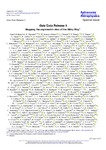Gaia Data Release 3: Mapping the asymmetric disc of the Milky Way

Use este enlace para citar
http://hdl.handle.net/2183/37646
Excepto si se señala otra cosa, la licencia del ítem se describe como Creative Commons Attribution License CC BY
Colecciones
- Investigación (FIC) [1605]
Metadatos
Mostrar el registro completo del ítemTítulo
Gaia Data Release 3: Mapping the asymmetric disc of the Milky WayAutor(es)
Fecha
2023Cita bibliográfica
Gaia Collaboration, Drimmel, R. et al. (2023). Gaia Data Release 3: Mapping the asymmetric disc of the Milky Way. Astronomy and Astrophysics, 674. https://doi.org/10.1051/0004-6361/202243797
Resumen
[Abstract] Context. With the most recent Gaia data release, the number of sources with complete 6D phase space information (position and velocity) has increased to well over 33 million stars, while stellar astrophysical parameters are provided for more than 470 million sources, and more than 11 million variable stars are identified.
Aims. Using the astrophysical parameters and variability classifications provided in Gaia DR3, we selected various stellar populations to explore and identify non-axisymmetric features in the disc of the Milky Way in configuration and velocity space.
Methods. Using more about 580 000 sources identified as hot OB stars, together with 988 known open clusters younger than 100 Myr, we mapped the spiral structure associated with star formation 4−5 kpc from the Sun. We selected over 2800 Classical Cepheids younger than 200 Myr that show spiral features extending as far as 10 kpc from the Sun in the outer disc. We also identified more than 8.7 million sources on the red giant branch (RGB), of which 5.7 million have line-of-sight velocities. This later sample allows the velocity field of the Milky Way to be mapped as far as 8 kpc from the Sun, including the inner disc.
Results. The spiral structure revealed by the young populations is consistent with recent results using Gaia EDR3 astrometry and source lists based on near-infrared photometry, showing the Local (Orion) Arm to be at least 8 kpc long, and an outer arm consistent with what is seen in HI surveys, which seems to be a continuation of the Perseus arm into the third quadrant. The subset of RGB stars with velocities clearly reveals the large-scale kinematic signature of the bar in the inner disc, as well as evidence of streaming motions in the outer disc that might be associated with spiral arms or bar resonances. A local comparison of the velocity field of the OB stars reveals similarities and differences with the RGB sample.
Conclusions. This cursory study of Gaia DR3 data shows there is a rich bounty of kinematic information to be explored more deeply, which will undoubtedly lead us to a clearer understanding of the dynamical nature of the non-axisymmetric structures of the Milky Way.
Palabras clave
Galaxy, kinematics and dynamics
Galaxy, structure
Galaxy, disk
Galaxy, bulge
Catalogs
Galaxy, structure
Galaxy, disk
Galaxy, bulge
Catalogs
Versión del editor
Derechos
Creative Commons Attribution License CC BY






